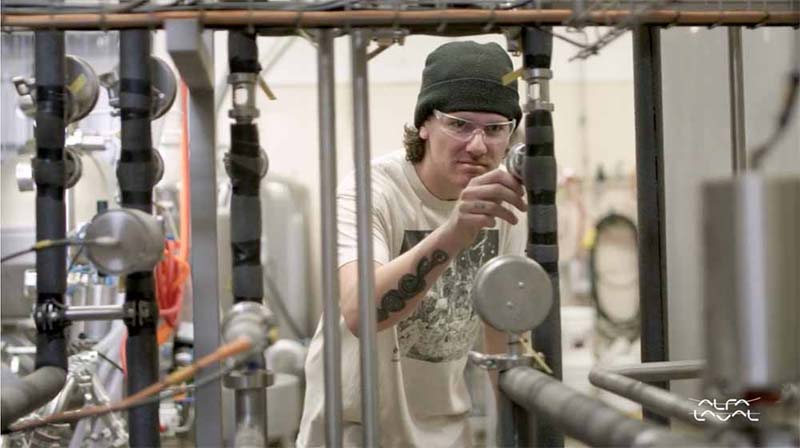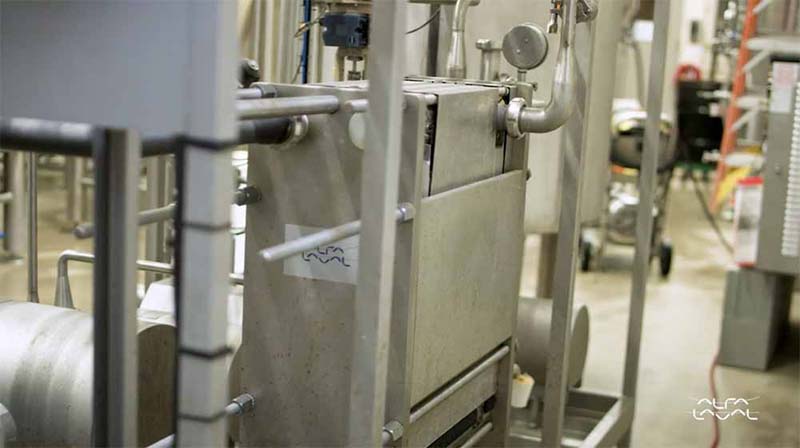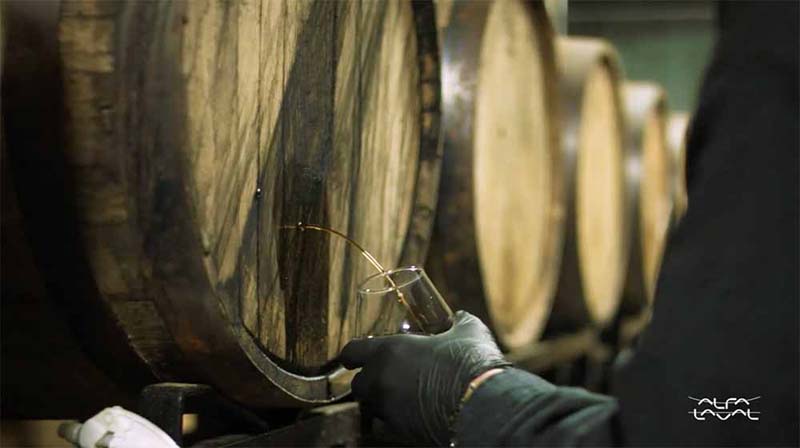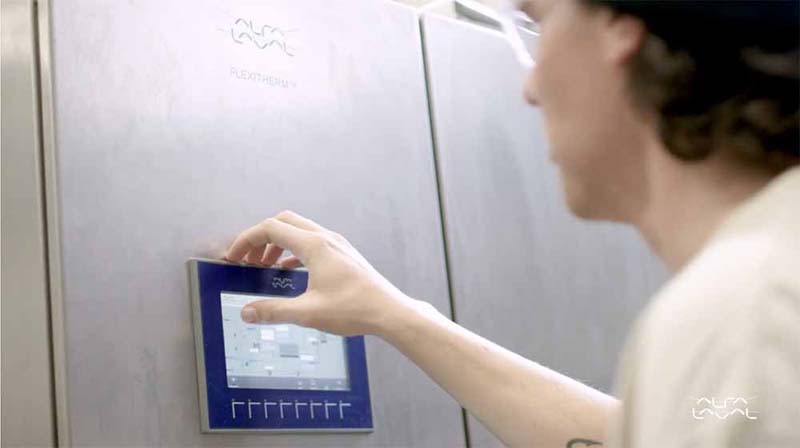
If we had to boil craft beer down to one word, it would be quality. Ask any craft brewer worth their hops what their mission is, and they’ll respond that they’re trying to produce the best beer, whether a hazy IPA, Cold IPA, or helles. What unites all these styles is that by the time they reach a customer’s lips, they should taste just as fresh, just as carbonated, and just as good as when originally brewed.
But often, this can be a difficult challenge.
Just think about the journey of that can (or bottle). How did it get to a store shelf?
After being packaged, it probably found its way onto a pallet, onto a refrigerated truck, and hopefully ended up in a store owner’s hands mere days later to stack on the shelf.
But each of those touch points presents opportunities for oxygen or temperature to affect the quality of the liquid inside. And that’s even if everything goes right along the transportation and supply chain.
“The further your beer is distributed from the brewery, the less control you have over how your beer is handled and cared for,” says Vince Polino, business development manager for Alfa Laval, one of the leading global suppliers of flash pasteurizers. “It could sit on a warm shelf for months before getting into a customer’s hand, and it could change drastically from what a brewer originally intended.”
For that reason, to truly ensure the quality of their product, some breweries use a flash pasteurizer, a machine that kills any of those potential beer-spoiling bacteria before packaging.
We talked to two breweries well versed in this process—Gordon Biersch and Jackie O’s—to discover the best reasons to invest in a flash pasteurizer.
(Photography courtesy of Alfa Laval)
Affordable, Industry-Leading Brewery Software
What Is a Flash Pasteurizer?

Photography courtesy of Alfa Laval
Simply put, a flash pasteurizer removes potentially harmful bacteria from a beverage-in-the-making, preserving its quality.
Alfa Laval has been providing their model, Flexitherm, to brewery and beverage customers for over thirty years, with hundreds of installations globally at small and big breweries.
“Flexitherm is an in-line flash pasteurization module designed to destroy spoiling microorganisms,” says Polino. “It can be used to extend the shelf life of beer, wine, cider, kombucha, hard seltzer, and other beverages.”
At a high level, Polino explains that the “product is heated to a set pasteurization temperature and then held at that temperature for a certain amount of time, based on the pasteurization units, or PUs, that you want to impart on the product.”
This gentle rise in temperature kills those pesky microorganisms that could potentially spoil your beer or alcoholic beverages, mitigating risk later down the line.
The Best Reasons to Invest in a Flash Pasteurizer

Photography courtesy of Gordon Biersch
Flash pasteurizers have helped breweries across the country, from Gordon Biersch to Jackie O’s in Ohio, improve the shelf life of their products and ultimately produce the highest-quality ales and lagers, barrel-aged beers, and more.
Better Shelf Life
“It’s an insurance policy,” says Dan Gordon, co-founder, and CEO at Gordon Biersch Brewing Co. in San Jose, CA, who has been using flash pasteurization across many of Gordon Bierch’s products for the past two decades. “We are proud we operate in a sterile [environment] day to day, but you always worry … [Flash pasteurization] gives you safety on shelf life.”
Gordon purchased Alfa Laval’s Flexitherm over twenty years ago when they encountered a big problem.
“The day and age of cold storage throughout the supply chain had started eroding,” says Gordon. In other words, once beer left the brewery, so many variables could affect the shelf life and quality that Gordon felt he had to take things into his own hands right at the source.
For instance, Gordon Biersch produces a couple of private-label beers for large retailers such as Costco and Trader Joe’s, where the supply chain is not refrigerated. That posed a problem for Gordon Biersch because the lack of cold storage could affect their end product.
Flash pasteurization preserves Gordon Biersch’s products as they move through the supply chain, ensuring they reach the shelf and the customer at the highest quality possible.
Prevents Spoilage and Recalls
Several years ago, Jackie O’s President Art Oestrike had a different problem. The brewery’s barrel-aged beers became infected. “Barrel aging beer is a fickle business,” says Oestrike. “You take this big beautiful imperial stout or barleywine, throw it into a freshly dumped bourbon barrel, let it sit in our warehouse for ten months, twenty-four months, thirty-six months, and a year and a half after packaging they started to turn; they became sour when they weren’t supposed to.”
After all the hard work the brewery had put into producing what should have been barrel-aged beauties, bacteria and microbes spoiled the party, forcing the brewery to recall twelve different products.
“It was disheartening,” says Oestrike. “I didn’t want to have any more sleepless nights wondering whether these products were going to turn, if they’re going to turn, or how they’re going to turn.”
So Oestrike started to look at his options to prevent this problem from happening again.
And just like Gordon, he found the answer was a flash pasteurizer.
Since investing in a flash pasteurizer, Oestrike can rest easy at night knowing that after sending Jackie O’s barrel-aged beers through the machine, “they are going to be good for years to come,” says Oestrike. “The [Alfa Laval] Flexitherm Mini flipped our barrel aging program on its head. We don’t have issues anymore. I really wish we had purchased that three or four years before then because it alleviated some of the headaches we found along the way.”
According to Polino, Jackie O’s isn’t the only brewery that’s run into this problem with barrel-aged beers. “After the headache and cost of a recall, the investment in a flash pasteurizer starts to look pretty good,” says Polino.
Oestrike certainly agrees, “In the end, the Flexitherm has given us the ability to feel more comfortable playing around with our barrel-aged products and have that much more confidence at the end of the day that those products will be shelf stable and delicious.”
Preserves Flavor and Quality
Using a flash pasteurizer is the gentlest way to treat and protect a product, maximizing the intended flavor and characteristics.
When Gordon Biersch first looked at different preservation technologies, not all looked good: Tunnel pasteurization cooked beer for around forty minutes, accelerating the product’s aging process, and sterile filtration stripped a beverage of its flavor.
But flash pasteurization, on the other hand, uses a rapid, gentle heating process (typically thirty to sixty seconds) to kill any potential beverage-spoiling bacteria. The least damaging to beer quality, flash pasteurization also kept much of the beverage’s flavor intact.
For Gordon, a flash pasteurizer seemed like a win-win.
“Flash pasteurization is least damaging to beer quality and actually produces a better alternative to sterile filtration, which strips a lot of flavor out,” says Gordon. “We weighed the advantages and disadvantages and elected to go with flash pasteurization.”
Since purchasing a flash pasteurizer, Gordon says, “We never regretted doing this once.”
One Big Misconception About Flash Pasteurizers

Photography courtesy of Alfa Laval
One of the biggest fears and misconceptions when using a flash pasteurizer is that it will change the beer’s flavor.
“There is a stigma that flash pasteurization could negatively impact the flavor or aroma of your beer or beverage,” says Polino. “I think people would be surprised how many wonderful beers they’ve had that were pasteurized—of all styles!”
Gordon agrees, “We’re running lagers, ales, you name it [through it], and we see equally good results flavor-wise across the board. From a layperson’s standpoint, no consumer can ever tell it’s been flash pasteurized.”
What Beer Styles Can You Put Through a Flash Pasteurizer?

Photography courtesy of Alfa Laval
You can use a flash pasteurizer for many beer and beverage applications.
“That could be putting beer into wooden barrels or adding fresh fruits, vegetables, nuts, spices, etc., from a local farm that has all kinds of things living on them, and you’re putting that directly into your fermenter,” says Polino, who also mentions applications with sour programs. “You run the risk of introducing fermentable sugar to a product with residual yeast. Even one yeast cell is all it takes, they say, to kick off a new fermentation in the package.”
Polino notes that non-alcoholic or low-alcohol beer or kombucha benefit from going through a flash pasteurizer because alcohol acts as a preservative, so “you may need to take extra precautions at very low-alcohol beers to ensure shelf stability.”
Originally Gordon used flash pasteurization on the brewery’s beers, from lagers to ales.
And it worked like a charm. But as we all know, today’s craft beer industry is about much more than just beer.
“This is a piece of equipment that can cost you your business if it doesn’t work correctly … but we use it in so many different applications,” says Gordon, who notes he now runs Gordon Biersch’s spiked seltzer, non-alcoholic (NA) beer, and even hard cider through the Flexitherm.
“If I can clean up apple juice with microbes successfully every time, that says a lot,” says Gordon.
Running everything from kombucha to hard cider through the flash pasteurizer eliminates these pesky problems.
A Final Word on Flash Pasteurizers

Photography courtesy of Alfa Laval
Yes, according to Gordon, when you invest in a flash pasteurizer, there will be an upfront cost, often reaching a quarter of a million to a million dollars. Still, the overall impact and peace of mind outweigh the high price tag.
Gordon says at Gordon Biersch, they’re using their flash pasteurizer every minute of every day. “This has been an incredible, great experience,” he shares. “There is no reason not to stick with a winner; that’s the way I look at it.”



